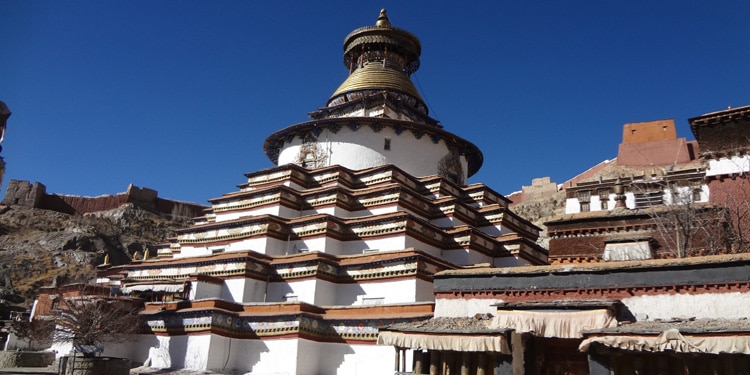
About 4,000 meters above sea level, the city of Gyantse had historical and cultural influence in Tibet. Gyantse was also a commercial center as the trails leading to India and China cross here. In the present time, this town lies on the Friendship highway connecting Tibet with Nepal. A fortress that came into action in the Second World War for training Tibetan soldiers was a British Military Garrison. With so much history and blooming memories from the past Gyantse is a lively town.
The story of the ‘Hero City’ Gyantse is worth listening to here. During the British invasion of Tibet in 1903 before the First World War, the British soldiers well equipped and large in number slowly came to invade Tibet resulting massacre of over seven hundred Tibetan soldiers in the process. Most of the defenders retreated from the area towards the Dzong. The Tibetans here then regrouped and attacked the British camp there. This attack cost them more than 200 more casualties. Even though the people here had inferior weaponry, they fought for three days and took control of the surrounding villages. Although the British canons and Gurkha soldiers made up to the fortress and broke into it, the heroism shown by the fearless Tibetan soldiers of Gyantse Dzong will be in the history golden pages for a long time to come.
Gyantse Dzong and Palcho Monastery are two of Gyantse’s unmissable places. In the fertile plains of Nyang River valley, a flood nearly destroyed Gyantse in 1954 AD. Surviving the odds is the motto of this town as it stands still after facing such hardships in the past. Called the city of heroes, for these various reasons, Gyantse is a link connecting pilgrims of the surrounding nations.
Gyantse Dzong is one of the oldest and most prominent fortresses that protected Lhasa from the southern side. Completed in 1390, the walls then were about 3 kilometers long. Lying in Gyantse city, this majestic Dzong stands tall in a huge spur of grey, brown rock. Now the ruins only remain of this great wall fortress and are singing the heroism of its history. Lying between a breathtaking landscape Gyantse Dzong is a place with smart design and architecture. In an elevation of 4,000 meters, the Gyantse Dzong has its inspiration of architecture from the Potala Palace. A site with magnificent landscape and glorious history Gyantse Dzong is worth a visit. Along with the Dzong, you can also visit the town and its different monuments at your leisure.
Palcho Monastery or Pelkor Chode Monastery here is a place you will regret to miss in your Tibet visit. The monastery is the largest Chorten in Tibet with over 10,000 murals in its six floors. The monastery also has a significant Nepalese influence in its art and architecture. Almost the only monument from this beautiful city that survived the natural disasters, as well as the Chinese revolution, Gyantse and Palchen monastery, is a destination to remember for a long time.
Major Attractions
Pala Manor – The epitome of Tibet’s past
Palcho Monastery / Pelkor Chode Monastery- Synthesis of Tibetan Culture
Gyantse Dzong
Amazing landscapes and Natural scenery







